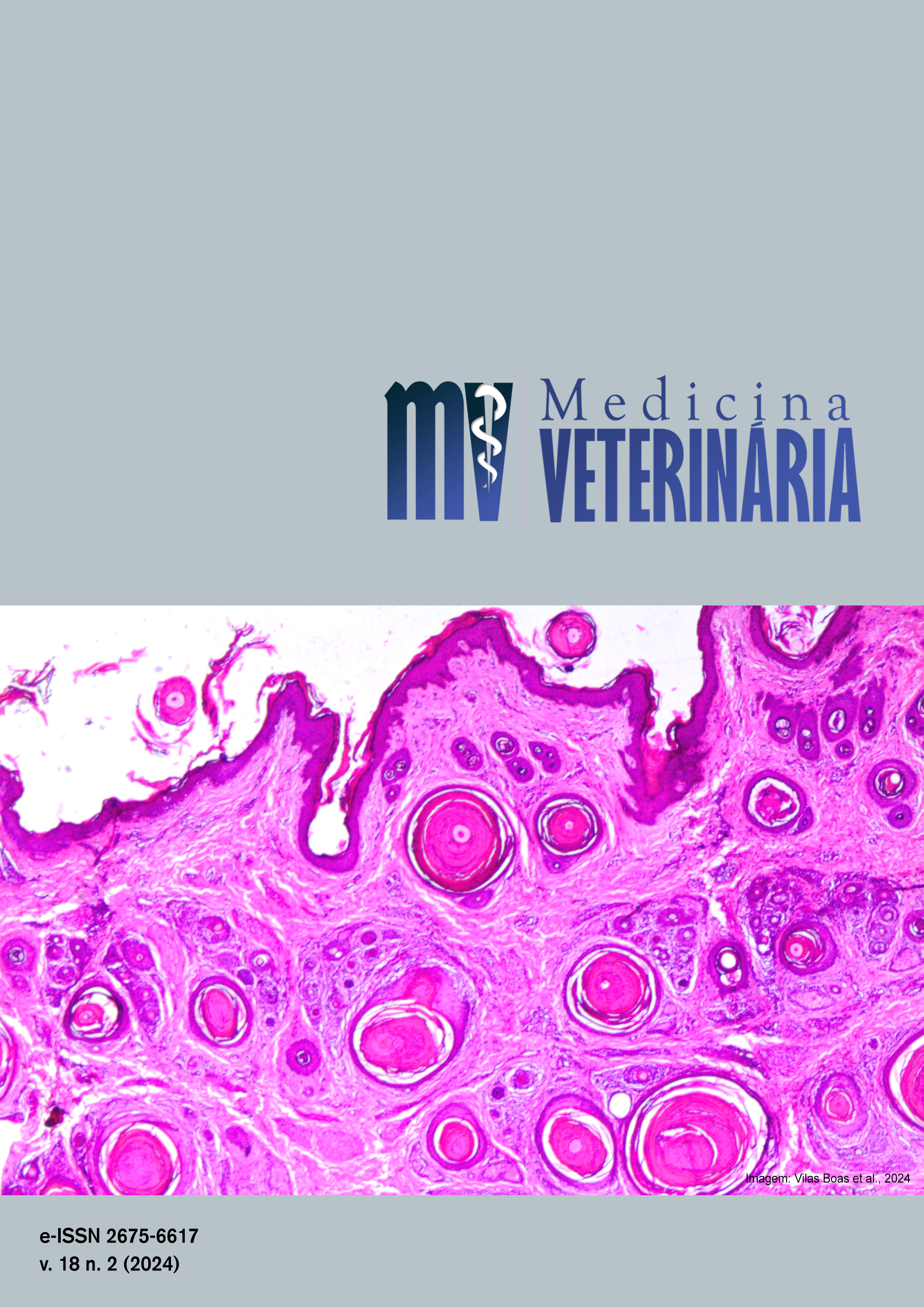Presumptive diagnosis of central diabetes insipidus with possible origin secondary idiopathic etiology
DOI:
https://doi.org/10.26605/medvet-v18n2-6004Keywords:
desmopressin, hyposthenuria, antidiuretic hormones, polydipsia, polyuriaAbstract
Diabetes insipidus (DI) is an infrequent endocrine disorder in cats caused by alteration in the synthesis and/or secretion of antidiuretic hormone (ADH), or by renal tubular inability to respond to the hormone. This endocrine disorder can have varied origins. The aim of this article was to report a case of diabetes insipidus in a 5-year-old mixed breed female cat, complaining of polyuria (PU) and polydipsia (PD), initially diagnosed as chronic kidney disease (CKD). The patient had already been evaluated by a professional, who found anemia, dehydration, azotemia and ultrasound changes suggestive of acute renal failure. Due to the concern of the owner, the patient was evaluated for another professional that observed a history, previous laboratory tests, and it was observed that the animal had a satisfactory body score, normal colored and hydrated mucous membranes, presence of gingivitis in the molar and premolar teeth, and moderate halitosis. The urinalysis showed isosthenuria, with no other alterations in the urinary analytes. Ultrasound examinations revealed maintenance of the corticomedullary architecture, discreet points of cortical mineralization and discreet dilation of the renal pelvis. The differentials of diabetes mellitus and hyperthyroidism were ruled out. Based on the clinical condition, diabetes insipidus was suspected, and the diagnosis was confirmed after a positive response to the use of desmopressin by the conjunctival route and increased urinary density.Downloads
References
Aroch, I. et al. Central diabetes insipidus in five cats: clinical presentation, diagnosis and oral desmopressin therapy. Journal of Feline Medicine and Surgery, 7(6): 333–339, 2005.
Bellastella, A. et al. Subclinical diabetes insipidus. Best Practice & Research Clinical Endocrinology & Metabolism, 26(4): 471-483, 2012.
Duperrier, C. et al. A case of central diabetes insipidus associated with a congenital cyst of the sella turcica in a young cat. Journal of Feline Medicine and Surgery Open Reports, 6(2): 2055116920935017, 2020.
Evenhuis, J. et al. Congenital pituitary cyst resulting in adipsic central diabetes insipidus and secondary hypernatremia in a cat. Journal of Feline Medicine and Surgery Open Reports, 7(1): 2055116921990294, 2021.
Medeiros, L.K.G. et al. Central Diabetes Insipidus in a Cat. Acta Scientiae Veterinariae, 42(1): 1-4, 2014.
Nelson, R.W.; Maggiore, A-M.D. Disorders of the hypothalamus and pituitary Gland. In: Nelson, R.W.; Couto, C.G. Small animal internal medicine. 6th ed. St. Louis: Elsevier, 2020. p. 740-757.
Oliveira, K.M. et al. Head trauma as a possible cause of central diabetes insipidus in a cat. Journal of Feline Medicine and Surgery, 15(2): 155-159, 2012.
Paulin, M.V.; Gleasure, S.; Snead, E.C. Multiple pituitary hormone deficiencies in a kitten: Hyposomatotropism, hypothyroidism, central diabetes insipidus and hypogonadism. Canadian Veterinary Journal, 64(3): 245-251, 2023.
Plumb, D.C. Plumb's Veterinary Drug Handbook. 7a ed. New Jersey: Wiley-Blackwell, 2011. 1584p.
Reppas, G.; Foster, S.F. Practical urinalysis in the cat 1: Urine macroscopic examination ‘tips and traps’. Journal of Feline Medicine and Surgery, 18(3): 190-202, 2016.
Silva, L.B.B. et al. Diabete insípido central congênita em um cão – Relato de caso. Revista de Educação Continuada em Medicina Veterinária e Zootecnia do CRMV-SP, 14(3): 56-56, 2016.
Simpson, C.J. et al. Central diabetes insipidus in a cat with central nervous system B cell lymphoma. Journal of Feline Medicine and Surgery, 13(10): 787–792, 2011.
Downloads
Published
How to Cite
Issue
Section
License
Copyright (c) 2024 Alisson Paulo da Silva, Felipe Gaia de Sousa, Jennifer Aragão da Silva, Jéssica Ragazzi Calesso, Suzane Lilian Beier

This work is licensed under a Creative Commons Attribution-NonCommercial-ShareAlike 4.0 International License.
A Revista de Medicina Veterinária permite que o autor retenha os direitos de publicação sem restrições, utilizando para tal a licença Creative Commons CC BY-NC-SA 4.0.
De acordo com os termos seguintes:
Atribuição — Você deve dar o crédito apropriado, prover um link para a licença e indicar se mudanças foram feitas. Você deve fazê-lo em qualquer circunstância razoável, mas de nenhuma maneira que sugira que o licenciante apoia você ou o seu uso.
NãoComercial — Você não pode usar o material para fins comerciais.
CompartilhaIgual — Se você remixar, transformar, ou criar a partir do material, tem de distribuir as suas contribuições sob a mesma licença que o original.
Sem restrições adicionais — Você não pode aplicar termos jurídicos ou medidas de caráter tecnológico que restrinjam legalmente outros de fazerem algo que a licença permita.







